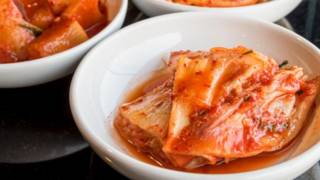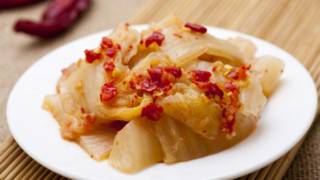级别: 总版主
   UID: 124
UID: 124
精华:
9
发帖: 13512
财富: 26414 湾区元
威望: 4766 点
支持度: 40 点
好评度: 23 点
在线时间: 325(时)
注册时间: 2011-07-26
最后登录: 2025-12-31
|
解开韩国泡菜独特味道的关键秘密
来源:BBC中文网 作者: 维罗尼克·格林伍德(Veronique Greenwood)
第一次吃泡菜,可能并不是每个人都会喜欢它的味道。对于不习惯这种口味的人来说,这种经过腌制的白菜似乎太酸了——而一旦涂抹在上面的辣椒闯入你的鼻窦,肯定会把你辣得涕泪横流。但如果一口接一口地吃下去,你迟早会爱上它那经过发酵而萌发出的独特美味。很显然,这种美食如今已经受到很多人的追捧: 纽约经常能见到加入了泡菜的奇特汉堡,泡菜汤也登上了各大美食网站的头条,在家中自制泡菜的秘方同样随处可见。 不过,尽管泡菜显然很有生命力——如果你把它放在冰箱的罐子里保存一段时间,或许会发现它会起泡——但它在制作过程中发生的自然变化仍然有些神秘。早期,为了研究那些将白菜和其他调料转化成泡菜的微生物,科学家会用棉签蘸取经过发酵的汤汁,然后进行培养,借此确定其中都包含哪些细菌。但现在却发现,这种方法难以反映全貌。很多细菌都是无法在实验室环境中生长的。  泡菜的微生物构成会随着时间的推移而不断变化(图片来源:Getty Images) 泡菜的微生物构成会随着时间的推移而不断变化(图片来源:Getty Images)但研究人员一直在尝试其他方式——同样的方法也被用于确定肚脐和阴道中的菌类。这就需要从样本中提取DNA,然后通过不同菌种之间的基因序列差异判断其中究竟包含哪些菌类。 这种研究方式更加明确地揭示出,究竟是什么造就了美味的泡菜。在其中一项研究中,科学家使用了30袋真空包装的泡菜,这些泡菜都由韩国工厂出品,并保存在该工厂的常规泡菜制作环境中——温度约为4摄氏度(39华氏度)。之后,他们每天都会打开其中的3袋,倒光里面的汁液后再放到离心机里旋转,然后从底部收集细菌,并破坏细胞结构,从而获取DNA。他们还会收集细菌微粒的相关数据。 泡菜的微生物生态环境发生变化时,它的化学成分也会随之改变。 他们发现,随着时间的推移,泡菜中的微生物种群会发生剧烈变化。起初,经过盐水浸泡、沥干并混入各种调料的白菜中,主要包含的是一种未经确认的细菌以及脱铁杆菌属的一些菌种,这种细菌可以在油田和深海虾类的内脏中找到。这些细菌只是在开始阶段存在于白菜上,与发酵过程并没有任何联系,因为过几天后,随着氧气耗尽,其他的菌类慢慢成为主角。 到第7天,明串珠菌属的DNA开始增加,这种菌类可以将糖转化成乳酸,正是它促成了开菲尔(kefir,一种发酵乳)和酸面包的发酵。到第13天,乳酸菌属和魏斯氏菌属也加入进来。与明串珠菌属类似,乳酸菌属和魏斯氏菌属利用糖产生了乳酸,它们也是奶酪、开菲尔、酱菜和其他发酵食品背后的功臣。在剩余的实验过程中,泡菜中的细菌都以这三种菌属为主。 专门感染细菌的病毒当泡菜的微生物生态环境发生变化时,它的化学成分也会随之改变。最初的15天,pH值的酸性逐渐增强,然后突然下降,最终停留在pH 4.5左右。这与西红柿浓缩汤的酸度相同,也是泡菜最适宜的酸碱度水平。随着乳酸菌占据主导,葡萄糖和果糖含量下降,醋酸盐和乳酸含量上升。甘露醇(在转化过程中生成的一种甜味糖醇)含量也会上升,符合常见的发酵流程。很多论文都指出,在不同的温度下,这种化学变化的速度会有所改变,参与其中的微生物数量也会有所不同。但最终的结果仍然将酸度和醇类的口味完美地融合到一起。  泡菜里不仅有细菌,还有病毒(图片来源:Getty Images) 泡菜里不仅有细菌,还有病毒(图片来源:Getty Images)奇怪的是,该团队还通过DNA测序发现,泡菜中含有很多专门感染细菌的病毒。他们认为,感染程度或许也会对发酵流程产生一定的影响。 多数家庭自制泡菜的配方都建议你在一周内吃完——随着时间的推移,气味会越来越大,白菜也会开始分解。归根到底,由于泡菜中的生命体太多,导致它无法长时间储存。当你下一次品尝又酸又辣的泡菜时,应该多想想为你贡献这种美味的菌类——同时思考隐藏在食物背后的生命的故事。 http://www.bbc.com/ukchina/simp/vert_fut/2015/10/151030_vert_fut_the-secret-behind-kimichis-sour-tasteWhy is pickled Korean cabbage so tasty? It’s quite literally alive, BBC Future discovers.23 October 2015It might not be love at first taste for everyone when it comes to kimchi. To the unaccustomed, the Korean pickled cabbage can be mouth-puckeringly sour – and once the chilli smeared on it hits your sinuses, eye-wateringly spicy. But put one bite after another, and sooner or later you may find yourself looking forward to that fermented tang. It certainly inspires devotion in many people: Flourishes of kimchi now adorn fancy hot dogsin New York City, kimchi stews take pride of place on foodie sites and recipes for making it at home are everywhere.
But though kimchi is quite clearly, um, alive – if you keep a jar of it in the fridge for a while, you may notice it bubbling – its natural history is still a bit mysterious. Early studies into the microbes that transform the cabbage and other ingredients into their final state involved taking swabs from the fermenting fluid, culturing them on dishes, and identifying the bacteria that grew, which we now know doesn't give you anything close to the full picture. Many bacteria do not deign to grow in the lab.

The microbial make-up of kimchi keeps changing over time (Credit: Getty Images)
Researchers have been trying out other approaches, though – the same approaches used to classify the riot of bacteria in the belly button or in the vagina. This involves extracting DNA from a sample and looking for a barcode sequence that varies between bacterial species to get a sense of who's there.
Studies of that kind have given a clearer picture of what's creating that funky kimchi flavour. In one study, the researchers had 30 vacuum-sealed bags of kimchi made at a factory in Korea, kept them all at the factory's usual kimchi-making temperature of 4 C (39 F), and every few days opened three bags. They drained the fluid off, spun it in a centrifuge so the bacteria collected at the bottom and cracked the cells open to get at the DNA. They also collected data on the molecules the bacteria were releasing.
As the microbial ecology of the kimchi changed, so too did its chemistry
The picture they paint is that the microbial population changes fairly radically over time. At first, the cabbage, which was soaked in brine, drained, and mixed with a variety of seasonings, was populated mostly by unidentified bacteria and ones from theDeferribacterales group, whose representatives have cropped up in oilfields and in the guts of deep-sea shrimp. These bacteria may have been on the cabbage to begin with, rather than having anything to do with the fermentation, because as the days passed, and the oxygen ran out, others began to take over.
By the seventh day, DNA from the Leuconostoc group, which converts sugars into lactic acid and are behind the fermentation of kefir, a fermented milk drink, and sourdough bread, was on the rise. By day 13, members of the Lactobacillus and Weisellagroups had joined in.
Like Leuconostoc, Lactobacillus andWeisella produce lactic acid from sugar, and they're also part of the team behind cheese, kefir, pickles, and other fermented products. Together the three groups dominated the kimchi for the rest of the experiment.
Viruses upon bacteria
As the microbial ecology of the kimchi changed, so too did its chemistry. The pH gradually became more acidic over the first 15 days, then dropped precipitously, coming to a stop at around pH4.5. That's about same as pureed tomatoes and it's considered optimum for kimchi. As the lactic acid bacteria took over, the levels of glucose and fructose dropped and acetate and lactic acid levels rose. Amounts of mannitol, a sweet-tasting sugar alcohol produced in the conversion process, rose as well, fitting in with the general picture of fermentation. This chemical transformation happens at different speeds and abundances of the microbial players at different temperatures, as numerous other papers note. But the end result is still a nice mix of funky-tasting acids and alcohols.

Kimchi doesn't just contain bacteria, but viruses as well (Credit: Getty Images)
Oddly, this particular team also noticed a ton of viral DNA as well from viruses that just infect bacteria. They propose that the level of infection might influence the fermentation process somehow.
Most homemade kimchi recipes suggest you start eating the stuff within a week – as time passes, the funk grows and the cabbage starts to disintegrate. In the end, there's just too much living going on for kimchi to be truly shelf-stable. When you are next enjoying its spicy-sour kick, think about the bacteria that gave it to you – and ponder all the things we are still figuring out about life in our food.
http://www.bbc.com/ukchina/simp/vert_fut/2015/10/151030_vert_fut_the-secret-behind-kimichis-sour-taste[ 此帖被卡拉在10-30-2015 14:51重新编辑 ]
|